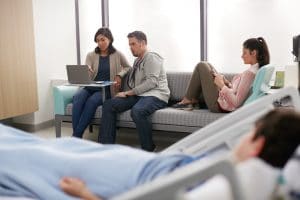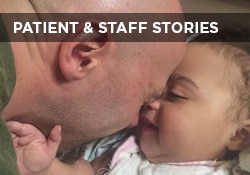This website uses cookies so that we can provide you with the best user experience possible. Cookie information is stored in your browser and performs functions such as recognising you when you return to our website and helping our team to understand which sections of the website you find most interesting and useful.

Susan E. Mazer, Ph.D. Blog
Thoughts and ideas on healthcare
Hi, and welcome to my blog! I'm Susan E. Mazer -- a knowledge expert and thought leader on how the environment of care impacts the patient experience. Topics I write about include safety, satisfaction, hospital noise, nursing, care at the bedside, and much more.
Addressing the Needs of Family in Patient Room Design
August 25, 2017

Photo courtesy of Steelcase Health.
It’s safe to assume that anywhere from 1-25 people are impacted when a person is hospitalized.
Those people could be parents, siblings, a spouse, children, adult children, other relatives, co-workers, employees, neighbors, and more. So, it makes sense that healthcare professionals talk about practicing patient- and family-centered care.
And there is more to consider.
Patients experience stress related to not being home for their kids or spouses or not being able to work. Basically, a whole family can be at risk because of the circumstances of the patient.
For that reason, when thinking about the physical environment of the patient room, it is critical to consider everyone who is with the patient.
Yes, there may be seating, but is it comfortable for people of all ages and abilities? Can a family member sit in the patient room and read or is the lighting designed only to support the caregiver?
New Research on Hospital Rooms by Steelcase Health
A recent article by Michelle Ossman, Ph.D., MSN in Medical Construction and Design described the ways patient rooms can help or hinder family involvement in care. Based on research by Steelcase Health, Ossman wrote that “Clinical literature confirms that appropriate family and friend involvement can reduce patient stress, contribute to safety by helping the staff know the patient and share in discharge and follow-up planning.”
However, Steelcase Health’s research found that “hospital rooms often lack support for family members’ underlying needs.”
Ossman then described a list of obvious needs that could be taken care of but are not always addressed, such as communications that risk being misunderstood or not even heard because the clinician does not directly address the family. Or uncomfortable sleeping arrangements that prevent family members from being fully present for patients.
Ossman also points out the difficulty in sharing a meal and maintaining any kind of routine. Often family members must work from the hospital or at least check in with their office. Plugging in a computer in the patient room may be difficult.
What About the Role of The Television?
What Ossman does not address, however, is the role of the television, which dominates both the auditory and visual space.
Stories of patients who finally calm down only to be stressed again by the television controlled by a family member who wants to watch a sports event, news, or something other than what may be best for the patient are common.
When we began producing The C.A.R.E. Channel 25 years ago, the television was dominant in patient rooms. And, commercial television was the only offering.
Then, as it is now, the speakers for the television are either in the bedrail, adjacent to the patient’s ear, or on the nurse call/television remote. In both cases, blasting the television for the benefit of visitors can easily be more than patients can manage.
Patients and families are best served by an environment that supports their ability to be connected, speak or just “be” together. Commercial television blaring in the background may not support that type of environment and certainly not over the full 24-hour patient day.
Also, broadcasting violent news stories, shows, or films to someone with PTSD can cause problems.
Helping Rather Than Hindering Recovery
The needs of family members and patients merge in so many ways. However, it’s best to use the television in a way that helps rather than hinders recovery.
Neither the news nor other kinds of current programming offer music and nature video like The C.A.R.E. Channel, without commercial breaks, specific to considerations of the medicated, highly acute viewing patient.
As Pat Linton, former CEO of North Hawaii Community Hospital, now with the Seven Mountains Foundation once said, “The only difference between the patient and the caregiver (and the family member) is acuity.”
Creating an environment that supports all those who come into the patients’ space will lead to better experience and better outcomes for everyone.
P.S. If you like this post, please do me a favor and share on LinkedIn, Twitter, Facebook, etc. Also to get automatic notices when a new post is published, please subscribe. No spam – just great content. Thanks!










